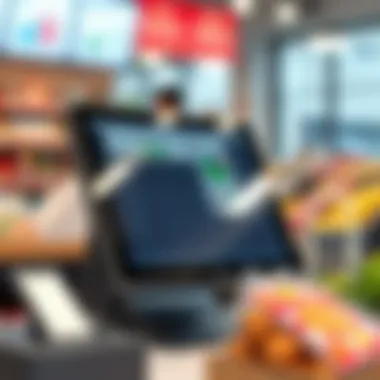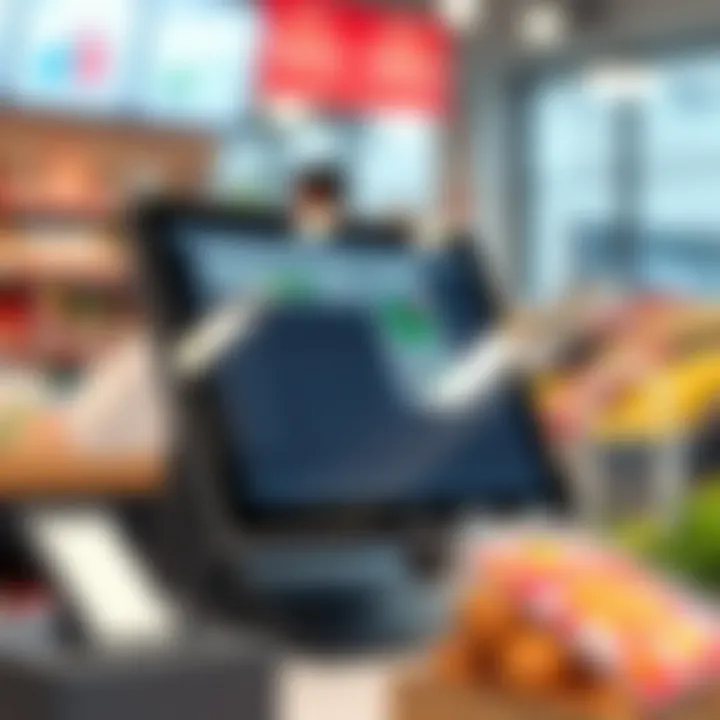Comprehensive Guide to Point of Sale Software


Intro
In today's fast-paced world, the way businesses handle transactions has evolved significantly. Point of sale (POS) software has become a cornerstone for operators ranging from small boutiques to large retail chains. Rather than being a mere cash register, modern POS systems have morphed into complex platforms that can manage inventory, track customer data, and even analyze sales trends. Given the rapid expansion of technology, selecting the right POS solution has turned into an intricate process worth analyzing.
This exploration is designed for those keen to understand the perks and pitfalls of various POS systems. Whether you're a financial planner advising clients on operational efficiencies or an investor gauging the viability of tech companies, a solid grasp of POS software can illuminate potential paths for growth and profitability. We'll dive into different aspects of various solutions, dissecting their functionalities while also examining their applications across industries.
By breaking down the terminology, integrating practical examples, and evaluating core features, this guide aims to empower users with insights necessary for making informed decisions. So, let's roll up our sleeves and dissect this crucial element of the retail landscape.
Prelims to Point of Sale Software
Point of Sale (POS) software is a critical component of in today’s fast-paced business landscape. It's not merely a tool for processing transactions but a linchpin that integrates various aspects of a business, from sales to inventory management. With consumers becoming more tech-savvy, businesses must adapt by employing sophisticated POS systems that enhance operational efficiency and customer satisfaction.
Defining POS Software
POS software is a digital system that helps businesses conduct transactions and manage sales data. At its core, it acts as the point where a customer completes a purchase and payment, often incorporating hardware like cash drawers, card readers, and receipt printers. This software isn’t just a cash register on steroids; it can track inventory levels, manage customer relationships, and provide detailed analytics on sales trends.
- Sales management: Allows businesses to process payments, track sales history, and manage refunds.
- Inventory control: Offers real-time insights into stock levels and ordering needs.
- Customer data handling: Manages loyalty programs and personalizes marketing strategies.
- Analytics and reporting: Provides critical data that helps in strategic business decisions.
In designing a robust POS software solution, developers need to consider the user interface and experience. It should be intuitive enough that even someone who isn't tech-savvy can navigate through it swiftly.
The Importance of POS Systems in Modern Business
In the current environment, where customer experience can make or break a business, having an effective POS system is paramount. These systems cater not only to the immediate financial transaction but also nurture ongoing customer engagement and ensure streamlined operations.
- Empowered Decision-Making: Through real-time sales data and inventory tracking, businesses can make informed decisions quickly. For instance, a retail store using POS software can identify which products are flying off the shelves and adjust their purchasing practices accordingly.
- Improved Customer Satisfaction: A swift checkout process is crucial for customer retention. POS systems offer features like mobile payments and loyalty programs that keep customers happy and coming back for more.
- Increased Efficiency: By automating regular tasks, POS systems free employees to concentrate on providing better service rather than being bogged down with administrative work.
As a result, POS systems are much more than software; they are a vital asset in modern business practices. They help businesses enhance operational performance and foster better relationships with customers.
"The best businesses are built on a foundation of data. POS systems enable that foundation to be laid solidly."
Key Features of POS Software
When selecting a point of sale system, understanding its key features is pivotal. These features can have a massive impact on how a business operates and manages its daily transactions. A solid POS system does not merely act as a checkout device; rather, it integrates various functions that streamline the entire sales process, ensuring better efficiency, improved customer experience, and real-time data insights. Business owners need to focus on what each feature brings to the table, as these can be game-changers in their operational efficiency.
Sales Processing
Sales processing is the heartbeat of any POS system. This feature ensures smooth transactions, whether a customer is paying with cash, credit, or mobile payments. A POS system should facilitate quick and simple checkout processes, minimizing wait times and enhancing customer satisfaction. Ideally, it should also allow for various payment methods, including contactless options like mobile wallets.
For instance, consider a small boutique that has a constant flow of customers. If the POS system can swiftly process multiple transactions, it can handle busy periods without causing delays. This capability not only keeps the lines moving but also leaves a good impression on the customer.
Inventory Management
Efficient inventory management is essential for any retail business. A POS system must facilitate seamless tracking of stock levels in real-time. When integrated with the sales processing feature, it provides accurate insights into what products are flying off the shelves and which ones are gathering dust.
For example, think of a local grocery store that uses its POS system to monitor inventory levels. When a product's stock drops below a certain threshold, the system can automatically alert managers to reorder supplies. This not only saves time but also prevents missed sales opportunities when items run out.
Additionally, some POS systems can manage purchase orders and track supplier information. This capability adds another layer of efficiency, allowing businesses to maintain optimal stock levels and establish productive relationships with suppliers.
Customer Relationship Management
Customer relationship management, often abbreviated as CRM, within a POS system can significantly enhance a business's ability to foster loyalty. Features such as customer profiles and purchase histories can help businesses tailor their marketing strategies and provide personalized service.
Imagine a coffee shop that keeps track of its customers’ favorite drinks. Armed with this information, the staff can greet regulars with recommendations or even set up loyalty rewards based on their spending habits. This proactive approach creates a more meaningful connection between the business and its patrons.
Furthermore, CRM features can automate follow-up communications, such as sending discount offers to repeat customers after a certain number of visits. This strategy not only keeps customers engaged but can also drive repeat sales.
Reporting and Analytics


The significance of reporting and analytics in POS software cannot be overstated. Having robust reporting tools means businesses can leverage sales data to inform decisions. A well-designed POS system enables users to generate various reports detailing sales trends, customer behavior, and inventory turnover rates.
For example, a clothing retailer can analyze which styles sold best during a particular season. By understanding these patterns, decisions regarding future inventory can be made with greater confidence.
Moreover, businesses can also assess employee performance, gaining insights into who the top sellers are and where improvements could be made. This data can guide training sessions and help motivate staff, fostering a culture of continuous improvement within the organization.
"Harnessing the power of data through effective reporting and analytics in POS systems can lead to astute business decisions that ultimately increase profitability."
In sum, the key features of POS software offer vital tools that can enhance operational efficiency, customer satisfaction, and data-driven decision-making. For any investor or business operator, understanding these features can lead to a more informed decision when selecting a POS solution. A truly effective POS system adapts to the needs of the business while providing insights that can spur growth.
Examples of POS Software
When we think about Point of Sale software, we're diving into a tool that can significantly influence how a business operates daily. From retail shops to bustling restaurants, examples of POS software show us the face of modern transactions and customer interactions. These systems are not just about ringing up sales; they can streamline operations, enhance the customer experience, and provide data that is instrumental for making informed business decisions. Understanding the nuances of different POS solutions can help business owners select the right fit for their unique needs and objectives. As we explore these examples, we'll uncover what makes each POS system tick and the specific advantages they provide to their respective industries.
Square POS
Overview of Features
Square POS stands tall among the plethora of solutions available today, primarily due to its user-friendly interface and robust functionality. It offers features like sales tracking, inventory management, and customer feedback tools, all wrapped into one compact package. One standout feature is its ability to accept various forms of payment, be it credit cards, mobile wallets, or even gift cards. This flexibility makes Square POS a favorite among small to medium-sized businesses seeking an affordable yet comprehensive solution. The intuitive dashboard allows users to visualize sales trends, which can aid in making rapid decisions based on real-time data.
Target Audience
Square POS is specifically tailored for small businesses, especially those in retail and food service. Its versatility makes it a worthwhile choice for entrepreneurs just starting out, as it requires minimal upfront investment and can be used effectively in various environments. The ease of setup and operation attracts independent sellers who may not have extensive technical expertise. However, larger enterprises might find some limitations in advanced functionalities, which are often needed as operations scale up. So, while it shines for smaller setups, bigger players might need to look elsewhere for robust options.
Pros and Cons
Every solution has its ups and downs, and Square POS is no different. On the plus side, it shines with its affordability and vast array of features. Business owners appreciate the transparent pricing model, avoiding hidden fees. But there are cons to consider; for instance, some users mention occasional connectivity issues, especially in low Wi-Fi areas. Plus, the reporting features, while solid, may not be as detailed as those found in high-end competitors. Balancing these pros and cons is crucial for business owners aiming for the right fit.
Shopify POS
Integration Capabilities
Shopify POS excels significantly in connecting online and offline sales seamlessly. A defining characteristic is its integration with Shopify's e-commerce platform, allowing retailers to manage both aspects under one umbrella. This integration means that inventory updates happening in the store reflect immediately on the website and vice versa, which is a game-changer for businesses that operate across multiple channels. Entrepreneurs relying on online sales can monitor physical store performances without the daunting task of separate inventory management systems.
Usability
Usability is where Shopify POS shines, thanks to its intuitive design and easy navigation. Users often commend the straightforward layout, enabling quick training for staff. The platform evolves based on merchant feedback, continuously improving the user experience. One unique feature is the mobile app, which allows sales to be processed anywhere, turning any location into a sales point. While its simplicity is a boon for beginners, some advanced users may crave additional customization options that the platform currently lacks.
Advantages and Disadvantages
Shopify POS offers considerable benefits for those venturing into retail, particularly for e-commerce business owners. It boosts collaboration between physical stores and online shops, driving sales effectively across all channels. However, one should keep in mind that some transaction fees apply, which may not work for every business setup. Additionally, as businesses grow, merchants might encounter limitations regarding user roles, particularly if they require multiple access levels within their teams.
Lightspeed POS
Industry-Specific Solutions
Lightspeed POS stands out due to its focus on providing tailored solutions for specific industries. Retail, hospitality, and e-commerce verticals benefit from specialized tools that cater precisely to their needs. For example, retail establishments can enjoy features like product variations and matrix inventory, while hospitality teams can benefit from tableside ordering and special menu management. This industry-specific approach means that users can leverage unique functionalities designed for their particular market, rather than using a one-size-fits-all solution.
Customer Support Options
An important aspect of any software is the support it offers. Lightspeed provides various customer support options, including live chat, email, and a comprehensive knowledge base filled with tutorials and FAQs. Their support team is known for being responsive and knowledgeable. However, some users have reported longer wait times during peak hours, which is something to keep in mind when considering Lightspeed for mission-critical functions.
Breakdown of Costs
Understanding the costs associated with Lightspeed is essential for businesses weighing their options. While the initial investment may be higher than some competitors, Lightspeed offers tiered pricing structures. This means users can select a plan that aligns with their specific operational needs. However, it’s worth noting that additional costs can crop up, especially when integrating third-party apps or requiring advanced features. Thus, a thorough financial assessment is advisable when considering Lightspeed as a POS solution.
Toast POS


Focus on the Restaurant Sector
Toast POS is particularly designed for the restaurant industry, offering a comprehensive solution tailored for food service providers. Its unique scheduling tools, online ordering capabilities, and kitchen display systems make it a preferred choice for restaurateurs. The robust management features allow for seamless tracking of orders, payments, and even employee shifts. This focus on the restaurant sector addresses the often-switching dynamics of a busy restaurant environment, providing necessary insights for operational efficiency.
Unique Functionalities
Standing out in a crowded market, Toast provides unique functionalities that can be particularly beneficial for restaurant owners. One such feature is the ability to create customizable menus that can easily adjust as per demand or seasonal changes. Moreover, it integrates loyalty programs seamlessly, which can enrich customer relationships and repeat business. However, the advanced features can come with a steeper learning curve for staff, impacting initial implementation.
Limitations to Consider
While Toast offers a wealth of benefits, it’s also important to recognize limitations. The system requires internet connectivity, which means disruptions in internet access can halt operations. Additionally, some smaller establishments express that the pricing model, which tends to cater to larger restaurants, may not be the best fit for them. Consideration of these factors can help in deciding whether Toast is the right choice for specific restaurant operations.
Evaluation Criteria for Selecting POS Software
Evaluating point of sale (POS) software is crucial for any business looking to maximize both efficiency and profitability. Since every business has unique operational needs, a comprehensive selection process is vital. Factors such as functionality, scalability, user experience, and customer support play significant roles in determining the best fit. By understanding these evaluation criteria, you can ensure that the selected POS system will not only meet current demands but also accommodate future growth and changes in the market.
Assessing Business Needs
The cornerstone of selecting the right POS technology is clearly identifying your specific business needs. Are you running a small retail shop, a bustling restaurant, or an e-commerce platform? Each of these environments demands different functionalities. For instance, a restaurant might prioritize table management and order tracking over traditional sales processing features that a retail store may require.
When assessing needs, consider the following:
- Sales volume: High-volume businesses might need faster transaction processing capabilities.
- Customer interactions: Some businesses may want a POS that enhances customer experiences through loyalty programs or personalized marketing.
- Regulatory compliance: Certain industries may need features to comply with local sales tax regulations or data management laws.
Determining these needs helps in filtering out irrelevant options early in the process. A clear understanding of your core requirements benefits greatly in making educated decision about the software.
Industry-Specific Applications of POS Software
The arena of point of sale (POS) software isn't a one-size-fits-all situation. Its industry-specific applications are pivotal as they tailor solutions that meet unique business requirements across different sectors. Here, we'll uncover how POS systems are reshaping the retail landscape, redefining food services, and integrating seamlessly into e-commerce, ensuring businesses remain competitive and efficient.
Retail Industry Applications
In retail, having a solid POS system can mean the difference between success and failure. The ability to manage sales, inventory, and customer interactions through a single interface creates a streamlined operation.
The varied functionalities in retail-focused POS include:
- Purchase Tracking: Monitoring stock levels in real-time helps businesses avoid running out of best-sellers, without accumulating dead stock.
- Sales Analytics: Understanding trends through data is crucial. Sales reports provide insight into busy seasons, which can guide marketing and stock decisions.
- Customer Profile Creation: Recognizing loyal customers through profiles facilitates targeted promotions, enhancing customer satisfaction and retention.
Certainly, one must be mindful of the learning curve associated with implementing such systems. A POS tailored for retail may be intricate and require staff training. Thus, having a support system in place is essential. It's about balancing efficiency with usability.
Restaurant and Food Services
In the bustling environment of a restaurant, POS software serves as the backbone for operations. With multiple transactions happening simultaneously, the need for a reliable and quick point of sale is paramount.
Key features relevant to restaurants include:
- Order Management: Collecting and processing orders swiftly minimizes mistakes and improves the dining experience for customers.
- Menu Customization: Flexible menu options allow restaurants to adapt quickly to changing food trends or customer preferences.
- Table Management: Some systems allow for easy tracking of table status, facilitating smoother service during peak hours.
Failure to implement an industry-specific POS in food services can lead to confusion or delays in orders—things customers certainly don't appreciate. Understanding unique restaurant needs can notably enhance the overall operational flow.
E-Commerce Integration
As the line between traditional retail and online shopping blurs, integrating POS software with e-commerce platforms is becoming increasingly critical. This integration ensures a unified view of sales and inventory across channels.
Advantages of e-commerce integration include:
- Consistency in Inventory Management: No matter where a sale originates, inventory updates reflect immediately across all platforms.
- Customer Insights: E-commerce-specific POS provides data on customer behavior, enabling informed marketing strategies.
- Streamlined Operations: It simplifies order processing, shipping management, and customer communication into one central system.


However, transition to an integrated environment isn’t without challenges. Businesses must consider their infrastructure, training, and support to ease the switch. Any hitches in this process could lead to missed sales opportunities and disgruntled customers.
Integration of POS with e-commerce can revolutionize how products and services are offered in the digital market, allowing businesses to reach wider audiences effortlessly.
Utilizing POS systems tailored to these industries empowers businesses to move forward without breaking a sweat, ensuring operations run as smooth as butter. For those looking to delve deeper, you might check out more about these systems on Wikipedia or dive into user discussions on Reddit.
Future Trends in POS Software
The landscape of point of sale software is constantly shifting, driven by technological advancements and changing consumer expectations. Understanding these trends is crucial for businesses looking to stay ahead of the curve. Companies can enhance efficiency, improve user experience, and cater to evolving market needs by adopting modern practices and technologies. Key trends such as cloud-based solutions, the integration of artificial intelligence and machine learning, as well as the rise of mobile and contactless payments will redefine how businesses operate.
In discussing these elements, it's vital to consider the benefits they bring, such as scalability, improved data management, and streamlined operations, not to mention their potential challenges.
Cloud-Based Solutions
Cloud computing has revolutionized the way software is deployed and maintained. POS systems that utilize cloud-based solutions provide several significant benefits. First, they allow for remote access, meaning business owners can monitor sales, inventory, and customer data from anywhere with an internet connection. This flexibility is invaluable for business owners who are often juggling multiple tasks.
Furthermore, updates and maintenance are managed by the provider, reducing the need for in-house IT resources. This can lead to lower overall costs since companies can avoid hefty initial investments in hardware. However, businesses must also assess the reliability of their internet connection; any downtime can impact sales operations dramatically.
- Advantages of Cloud-Based Solutions:
- Remote Access: Monitor your business real-time from anywhere.
- Cost-Effectiveness: Reduced hardware costs and ongoing maintenance fees.
- Scalability: Easily add features and functionalities as business needs grow.
In comparison, some companies might worry about data security with cloud systems. It’s essential for businesses to choose reputable providers with strong security measures in place to protect sensitive information.
Artificial Intelligence and Machine Learning Integration
The integration of artificial intelligence (AI) and machine learning into POS systems acts as a game-changer. These technologies empower businesses to analyze customer behaviors, preferences, and spending patterns, enabling more personalized consumer experiences.
For instance, AI can provide insights into peak sales times, allowing businesses to optimize staffing levels. Personalized marketing efforts can be enhanced by machine learning algorithms that analyze customer purchasing histories, enabling targeted promotions and recommendations.
- Key Benefits of AI in POS Systems:
- Enhanced Decision Making: Use data analytics for strategic planning.
- Customer Insights and Personalization: Tailored experiences based on user behavior.
- Operational Efficiency: Streamlined tasks and reduced manual intervention.
Yet, integrating AI can require substantial initial investment and might necessitate training for staff to fully utilize these advanced capabilities.
Mobile and Contactless Payments
Consumers increasingly demand convenience, which has accelerated the adoption of mobile and contactless payment methods. This trend is not just limited to smartphones; wearable technology is also on the rise, allowing users to make transactions directly from smartwatches or fitness bands.
POS systems that incorporate these payment methods provide not only convenience but also a boost in transaction speed. During busy periods, this can make all the difference. Contactless payments also lend themselves well to hygienic transactions, a consideration that has grown in importance in a post-pandemic world.
- Implications of Contactless Payment Solutions:
- Increased Speed at Checkout: Shorter wait times for customers.
- Enhanced Hygiene Practices: Reduced contact during transactions.
- Broader Customer Appeal: Attract younger consumers who prefer tech-savvy options.
Despite the advantages, some customers may still be skeptical about using contactless payments due to security concerns. Educating consumers about encrypted transactions and fraud protection is essential to mitigate these hesitations.
Culmination
In wrapping up our exploration of point of sale software, it's vital to recognize its significance in today’s fast-paced business environment. The points covered reflect the multifaceted nature of POS systems and serve as a reminder of their critical role across various industries.
Summary of Key Considerations
When selecting a POS solution, several critical elements demand attention:
- Business Needs: Before anything else, understand your business model. Will you need custom functionality for retail or maybe intuitive inventory tracking for a restaurant? Every sector has unique requirements that dictate what features should be prioritized.
- Scalability: As businesses grow, so do their demands. Choose a POS that allows for easy upgrades and expansions. This could mean adding new features or integrating with other tools without a hefty price tag.
- Cost: While sticking to a budget is important, it’s equally essential to assess the value a system offers. Sometimes, a more expensive option could yield better returns in the long run due to its robust features or superior customer support.
- User Experience: How intuitive is the interface for your employees? A complex system can slow down operations and frustrate staff. Opt for software that's straightforward to navigate and requires minimal training.
To summarize, understanding these factors is crucial for making an informed decision that aligns with business objectives. The consequences of misjudging these elements could lead to inefficiencies or unnecessary costs.
Navigating the Selection Process
Choosing the right POS software can be a daunting task, but breaking it down into manageable steps can ease the journey:
- Research Options: Start by exploring various POS systems. Gather data on features, user reviews, and industry comparisons. Websites like Wikipedia and Reddit have valuable insights and opinions from real users.
- Identify Must-Have Features: Not every feature suits every business. Make a list of what features are essential, such as mobile capabilities for on-the-go sales or advanced reporting tools for insights into sales trends.
- Demo and Trial: Request demos from several providers. This first-hand experience can reveal what works for your operations and what might be cumbersome.
- Reading Contracts Carefully: Terms and conditions can often hide fees or limitations. Ensure you know what you’re signing—sometimes, these details can influence your decision significantly.
- Get Feedback from Staff: Employees are the ones who will ultimately use the system day in and day out. Seek their feedback on the options considered. Their insights might highlight potential issues or advantages you might have overlooked.



